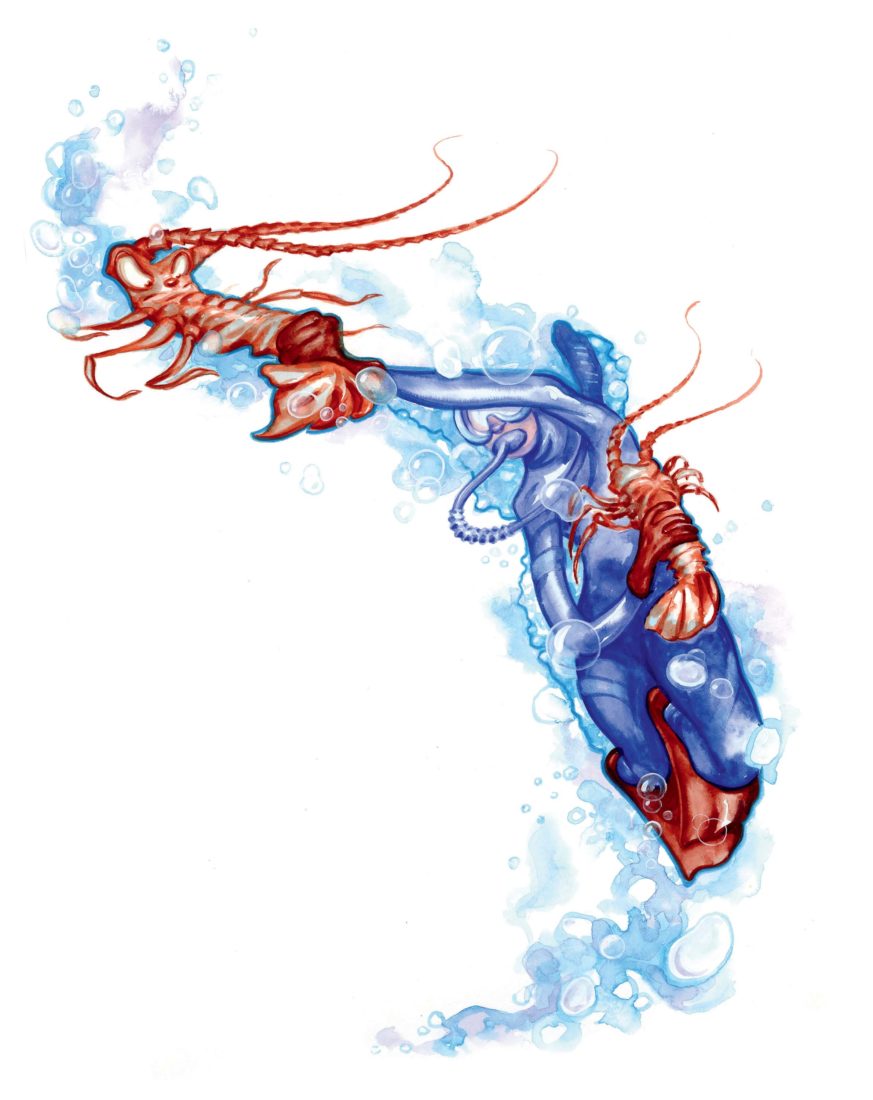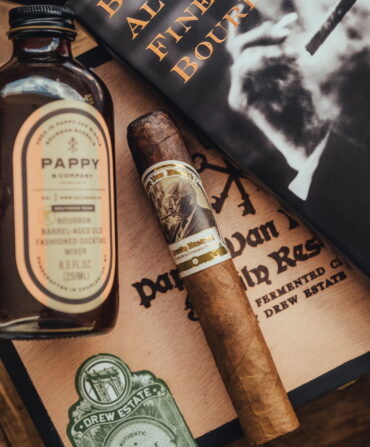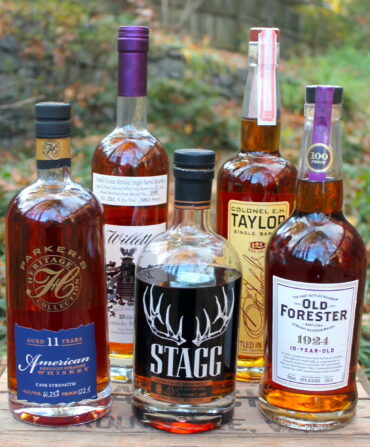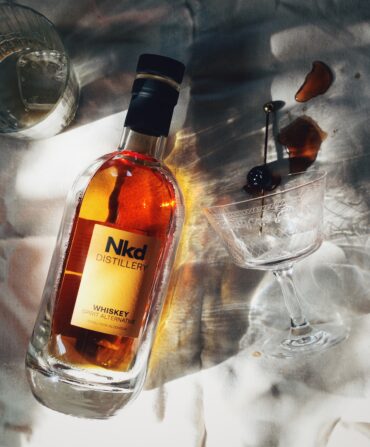SEAFOOD
Florida
DIP DEEP INTO LOBSTER SEASON
“I consider myself an underwater hunter,” says Jim “Chiefy” Mathie, a recreational diver in Broward County and the author of Catching the Bug: The Comprehensive Guide to Catching the Spiny Lobster. For thirty-five years now, and as often as he can during Florida’s lobster season, which begins August 6, Mathie dives among the reefs near Fort Lauderdale for spiny lobster. Sure, charter snorkel trips and free diving—with the right gear and a license—might also land you bugs, but Mathie prefers to scuba dive to the deeper parts of the reefs to coax out the antennaed nocturnal creatures. “Reach in with your tickle stick,” he says, “tapping very gently on the tail to move them out of their hole, and then catch them in the net.” Last season, Mathie found clusters of lobsters that were just barely too small (keeping a lobster with a carapace shorter than three inches is illegal), and he let them swim free to keep growing. “I think that says we’ll have a good season this year.” Back on the boat, he runs through his meal plan like a lobster-loving Bubba Blue: roasted lobster, grilled lobster, sautéed lobster, lobster stuffed with crab… Seek out some crustaceans yourself in late summer, when any seafood spot worth its salt in South Florida will serve the tender meat with an ample supply of garlic butter. myfwc.com
LEGUME
Alabama
BUTTER BEAN DREAMS
The butter beans that the restaurateur Pardis Stitt harvests on her family farm outside of Birmingham this time of year are sweet treasures to her. “They are just like celadon jewels,” says Stitt, who with her husband, the chef Frank Stitt, helms the B’ham institutions Highlands Bar & Grill, Bottega, and Chez Fonfon. The oldest daughter of Iranian American parents, Pardis grew up in Birmingham with Southern and Persian flavors on the table. “My mom would make a Persian rice and beans dish, baghali polo, with fava beans, and now my family always makes it with butter beans and basmati rice.” The process: In separate pots, cook butter beans (most of the rest of the country calls these flavorful legumes lima beans) and rice with clarified butter and olive oil, and then combine the beans and rice and add salt, saffron, and fresh dill. “You must add so much dill that you’ll have dill in your teeth,” she says. “And in my family, the prize is the tahdig, the layer of buttery and crispy sticky rice at the bottom of the pot.” stittrestaurantgroup.com
FRUIT
Arkansas
HEIRLOOM FIESTA
Chef Rafael Rios knows his tomatoes by name: There’s the Arkansas Traveler, big and beefy and slightly acidic, and two of Rios’s personal favorites, the Brandywine and the Cherokee Purple, sweet varieties that can weigh in at two pounds apiece. “When you eat a tomato grown the way it’s supposed to—outside, with the sun and rain, letting nature do its thing—you taste the difference,” says Rios, a James Beard Award semifinalist this year. He runs three iterations of Yeyo’s (a taco truck, a food hall stall, and a mezcaleria) in Northwest Arkansas, and at his family’s farm, he grows fifteen tomato varieties and is developing his own hybrids. Rios eats tomatoes straight off the vine, sprinkled with salt, and serves pico de gallo at his restaurants. “How to make pico de gallo is no secret,” he explains: lime squeezed over serrano peppers, coriander seeds, spring onions, and a tomato base. But using perfectly juicy heirlooms, as Rios does, will make that fresh pico something to crow about. yeyosnwa.com

LEGUME
Georgia
GOBS OF GOOBERS
A boiled peanut isn’t just any peanut thrown in hot water. “Make sure you’ve got yourself a green peanut,” says Alex Hardy of Hardy Farms Peanuts, which has been selling green and boiled peanuts at roadside stands throughout Georgia for three decades. Unlike dried peanuts, which go into tinned snacks and peanut butter, a green peanut is newly dug from the field, and has a high water content and a short shelf life. “Green peanuts are harvested fresh, boiled fresh, and served fresh,” Hardy says. Stewed in salty water, maybe with spices, the peanuts soften and take on a texture akin to that of their cooked legume relatives. As any Southern road-tripper knows, pots of boiled peanuts linger at gas stations year-round, but those are usually frozen, canned, or dried and then soaked. When handmade signs and humble stands pop up along country roads in August, September, and October, pull over knowing the getting’s good and green. hardyfarmspeanuts.com
DRINK
Kentucky
BET ON A CLASSIC
“There should be thirty-six sips in a mint julep,” says Chris Morris, the master distiller at Woodford Reserve, the official bourbon of the Kentucky Derby. Precise, yes, but Morris would know—he’s been mixing the drink at Churchill Downs on Derby Day for two decades, and even on live television. It’s a minute-long process before the two-minute race: Rub one or two mint leaves around a julep cup and drop them in the bottom along with a glug of powdered-sugar simple syrup; pour in two ounces of bourbon and nearly fill the cup with crushed ice; tuck a mint sprig next to the sipping straw. “This would have been my twenty-first year making juleps at the Derby,” Morris says. The coronavirus pandemic stopped just about everything in its tracks—from the horses to the two tons of fresh mint picked and packed in May. “Mint grows whether you’re going to use it or not,” points out Morris, and so a fresh supply will be ready at the gates for the new Derby date, September 5. kentuckyderby.com
SEAFOOD
Louisiana
TOTAL SOFTIES
As often as once a week over the course of their short lives, shrimp get naked and wiggle in the moonlight. For the few hours at night when white Gulf shrimp shed their tough skin and grow into a new size, they’re called soft-shell shrimp. “They look just like shrimp, but like they’re tired or something,” says Lance Nacio, a shrimper in Terrebonne Parish, about an hour south of New Orleans. “They’re limp.” But they’re also incredibly juicy—the whole time they’re bare, shrimp absorb water and become tiny flavor capsules of their Gulf and bayou homes. The chef Melissa Martin at Mosquito Supper Club in New Orleans dries soft-shell shrimp with paper towels and fries them for po’boys. “My family in the shrimp industry call me when they’ve got a bunch of soft-shells in their catch, and I go pick them out,” Martin says. “They are really delicate—and I realize not everyone has that kind of access in their life.” To get your hands on some, you’ll need to make friends with shrimpers such as Nacio, who has a freezer on board his Anna Marie and sells and ships bags of frozen softies as summer turns to fall and the shrimp really start to get jiggly. annamarieshrimp.com
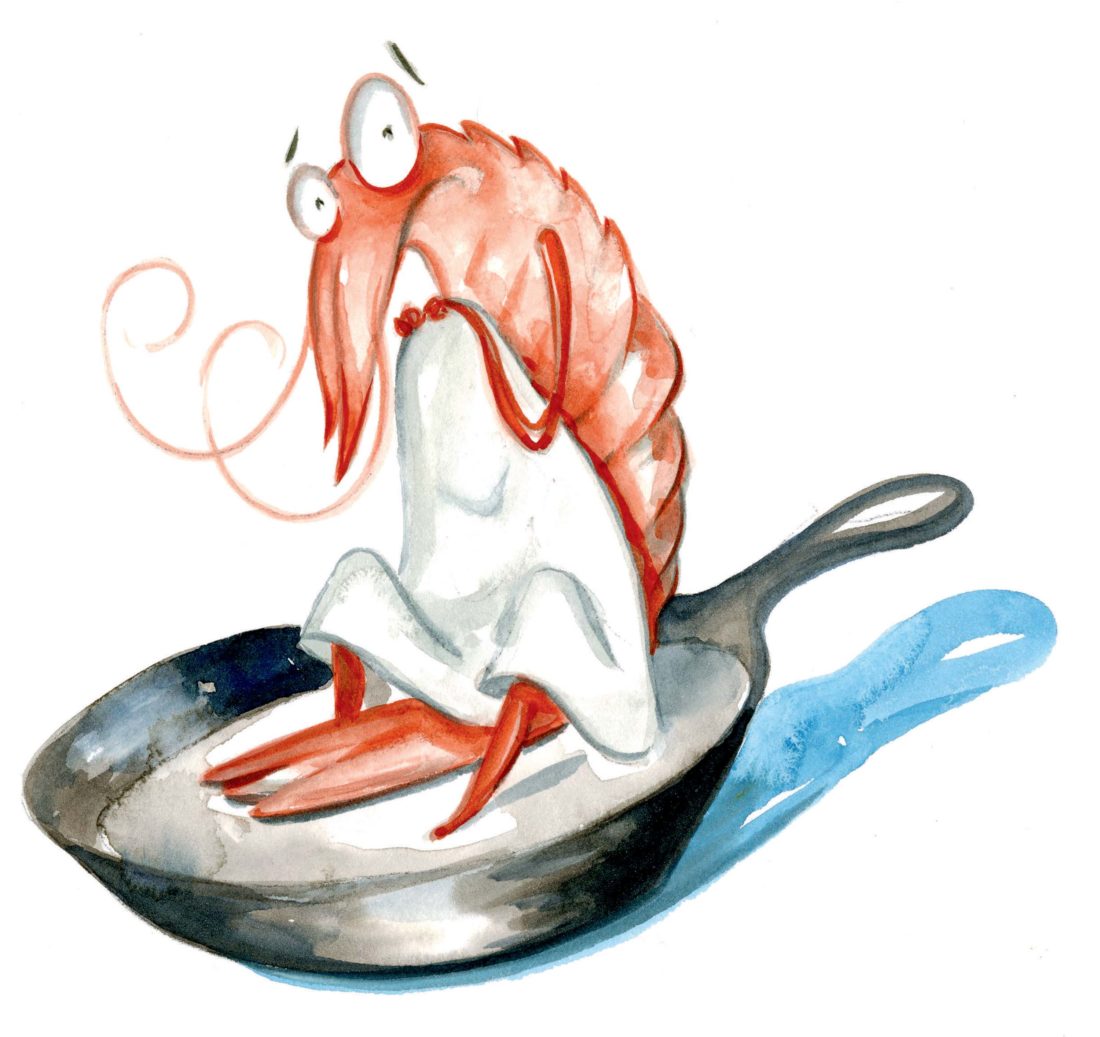
DRINK
Maryland
SQUEEZE PLAY
Mimosas and screwdrivers may have their permanent spots reserved at brunch and football tailgates, but in Maryland, the Orange Crush wears the citrus cocktail crown. In 1995, the owners of Harborside Bar & Grill in Ocean City created the drink when they poured vodka, orange juice, triple sec, and Sierra Mist over ice cubes. The waterfront bar has sold millions of Crushes since, squeezing oranges in an industrial juice press with every order, and watching other Old Line State bars catch on. Ryleigh’s Oyster, for instance, a beloved Baltimore seafood spot, sells thousands of its version in the summer months. “A lot of people try to make it easier by pressing the orange ahead of time,” says owner Brian McComas. “But the key is always the freshness of the juice.” Ryleigh’s has experimented with grapefruit, blueberry, watermelon, and lemon versions, and even subbed in local Sagamore whiskey for the vodka. Still, the classic reigns. “The drink has just ingrained itself,” McComas says. “It’s become Maryland’s cocktail.” weocharborside.com; ryleighs.com
SEAFOOD
Mississippi
A WRITER’S BIG BREAK
Read any of Eudora Welty’s stories and two traits become clear: She had a great love for people, and she had a dazzling sense of fun. Welty regularly invited friends to her home at 1119 Pinehurst Street in Jackson, where night-blooming flowers burst into fragrance, and friends discussed books, played games, and dipped into her plentiful stock of Maker’s Mark. One evening in 1985, Welty hosted the esteemed broadcast journalist Roger Mudd and made a crab casserole (Mississippi’s blue crab season stretches into late fall). As she removed the Pyrex dish from the oven, it slipped and the contents spilled across the floor. Undeterred, the friends ate crackers and beans and drank bourbon into the night. Two weeks later, Mudd received a postcard from Welty, which now resides with his papers at Washington & Lee University in Virginia. The front depicts the Cheshire cat; on the back, Welty scrawled her recipe for Eudora’s Crab Dish. Ingredients: Crabmeat, green pepper, onion, celery, mayonnaise, and spices. Preparation: “Remove from oven, immediately invert and allow to reach kitchen floor. Test and see if thoroughly shattered. If Roger Mudd is dinner guest, he will quickly appear and take care of everything. Serves 0.” eudorawelty.org
FRUIT
North Carolina
GRAPE FOR YOU
“Mama always told you to eat your fruits and veggies,” says Patricia Gallagher, a researcher at Wake Forest School of Medicine, “even if she didn’t know why.” As usual, Mama was right, especially when it comes to muscadines. In 2015, the Wake Forest Baptist Medical Center received the largest gift in its history, a $20 million anonymous donation to research the benefits of these hardy native Southern grapes, which contain antioxidant-packed compounds called dietary polyphenols. After five years of study, researchers found that a concentrated muscadine extract can improve hypertension-induced heart and vessel damage, and in a clinical trial, it reduced fatigue and improved physical function in patients with advanced cancer. But there’s a catch for those eaters who like only the flavorful gooey centers: The benefits are in muscadine skins and seeds. At least one winemaker in North Carolina understands: WoodMill Winery in Vale incorporates grape skins into the fermentation process. And for bakers, when muscadines ripen in late summer and start popping up at farmers’ markets, making a whole-fruit grape hull pie is now doctor approved. ncmuscadinegrape.org

GRAIN
Oklahoma
EARS TO THE GROUND
“We think that we are selecting, in control,” says Bill McDorman, the executive director of the Rocky Mountain Seed Alliance. “But corn is a mysterious plant.” He’s describing Glass Gem corn, with its jewel-like kernels of indigo, chartreuse, gold, and crimson. The rainbow effect results from the years an Oklahoma man named Carl Barnes spent crossbreeding Native American corns, including Pawnee miniature corn and Osage Greyhorse. “It was a spiritual endeavor,” McDorman says. “He let the corns dance together.” After Barnes died, in 2016, the alliance and others such as Native Seeds/SEARCH have continued his legacy by sharing the seeds with history-loving gardeners. Ground Glass Gem makes delicious cornbread, but it’s almost too pretty to eat. rockymountainseeds.org; nativeseeds.org
FRUIT
South Carolina
SWEET RESURRECTION
So prized for its sweet fruit and tender rind was the Bradford watermelon that farmers in the 1800s laced part of their crop with poison to deter thieves. “The watermelon has a curious, symbolic hold on people, and it inspires an extraordinary sense of property,” says David S. Shields, a culinary historian at the University of South Carolina. The Bradford seemed to disappear after the 1920s, when other melons’ shipping hardiness outranked flavor in importance. In 2006, Shields began a yearslong search for the melon; eventually he decided it was extinct, and even wrote an obituary for it. “I lamented that we would never again taste it,” Shields says. When farmer Nat Bradford read the article, he sent Shields a picture of his white-seeded watermelons; the family had never stopped growing them in Sumter. Since then, the Bradford, which ripens in August, has rebounded in Southern kitchens. Shields receives a yearly watermelon, courtesy of the family; you can reserve yours online. bradfordwatermelons.com
GAME
Tennessee
FORGET LOW AND SLOW
“You’ve gone all these months, you’re wanting to scratch that itch, you’re wanting to get out in the field,” pitmaster Pat Martin says, “and then, almost like that first college football game—dove season.” On September 1, opening day, the owner of Martin’s Bar-B-Que Joint will perch on a five-gallon bucket somewhere near Centerville, Tennessee, hunting birds. But come supper, you’ll find him at a grill, not a pit. “Barbecuing dove? I would not do it. Like other wild game, it’s tricky and it’s lean, but it’s not complicated.” After cleaning his birds, brining them for up to eight hours, and letting them dry in the fridge and then come to room temperature, Martin gets a Japanese yakitori grill going (he says a trusty Weber could also work—you’re looking for “the hot side of medium” heat). He blends a sauce of cane syrup, white or rice vinegar, and something sweet and in season, pureed—peaches, tomatoes, or blackberries. “The sauce is going to run, but that’s okay,” he says. “Let the bird sit on the heat for one minute, constantly basting that flavor on there, and then flip it, and it won’t take you but two minutes to cook dove.” martinsbbqjoint.com
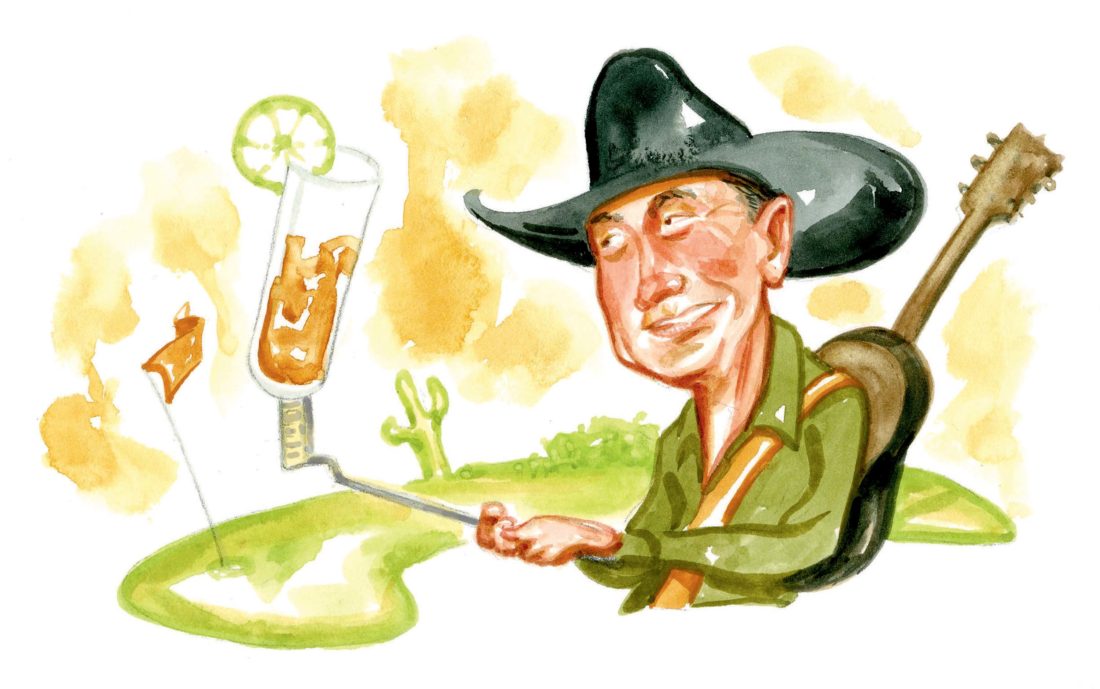
DRINK
Texas
BABY, WRITE THIS DOWN
George Strait wasn’t always a tequila drinker. But the legendary Texas country singer—who boasts more number-one hits than any artist in history—is a guy who knows when to change his tune. When a few of his buddies in Mexico shared a family stash of the spirit, Strait became a believer, and when they made the stuff commercially available under the brand Código 1530, Strait signed on as an investor. “Believe me, none of us were looking to start a tequila company,” he says. The King of Country especially enjoys when the agave spirit hangs out in the cupholder of his golf cart. “There’s a caddy down at El Dorado, one of my good friends, named Alberto Sanchez—everyone calls him Cuchara,” he says. “He’s a two-handicap golfer, way better than I’ll ever be. And he can make a mean twist on the Paloma.” At home, Strait makes an El Rey: an ounce and a half of reposado tequila, one ounce of fresh grapefruit juice, three-quarters of an ounce of lime juice, and six ounces of club soda on the rocks in a collins glass with a salted rim and a grapefruit peel. Strait likes it with nachos. codigo1530.com
MEAT
Virginia
PEDIGREED PORK
In a footnote in David Chang’s forthcoming memoir, Eat a Peach, the Virginia-raised chef known for his Momofuku restaurants (and his helpful quarantine Instagram videos) describes how some folks fell back in love with country ham: “Americans still only had eyes for Italian prosciutto when we first started serving paper-thin slices of smoked pork made in Tennessee, Kentucky, and Virginia from purveyors like Benton’s, Broadbent, Colonel Newsom’s, and Edwards,” Chang writes. Sam Edwards III makes it a point to visit Chang’s restaurants and thank him for helping renew interest in his family’s livelihood—and Edwards knows that many Southerners never stopped loving the stuff. “We are putting hams down heavy in anticipation of the holidays,” says Edwards, who takes orders year-round but sees his biggest rush in fall and winter. “It takes a regular country ham four to five months to age.” And in the heat of summer, while he waits for some of the world’s tastiest hocks to cure, he makes himself a sandwich: white bread, Duke’s mayo, vine-ripened tomato, crisp lettuce, and his hickory-smoked peppered bacon. edwardsvaham.com
SAUCE
Washington, D.C.
CAPITAL CONDIMENT
Found at Asian carryout spots throughout the city, a thin, red, sweet-and-spicy condiment called mumbo sauce is a D.C. insider secret. “When I was growing up in the eighties and nineties, we’d order wings ‘saltpeppermumbo’ like it was all one word,” says Doretea Burton. She passed along the love of her hometown’s sauce to her sons Andy and Nyles, the founders of Andy Factory, which bottles and ships mumbo sauce. (Not to be confused with a Chicago company’s trademarked “Mumbo,” which is why D.C. variations are often spelled “mambo,” but still usually pronounced with a u.) Residents pour it over chicken, french fries, and even salmon and meat loaf. Local hip-hop artists and go-go bands, who play the city’s native funk music, pay homage, such as when the Grammy-nominated Christylez Bacon wrote an entire song dedicated to it. “Very few things are unique to D.C. because it’s such a transient city,” Burton says. “It’s completely different than when I was growing up. The only things that remain are go-go music and mumbo sauce.” andyfactory.com
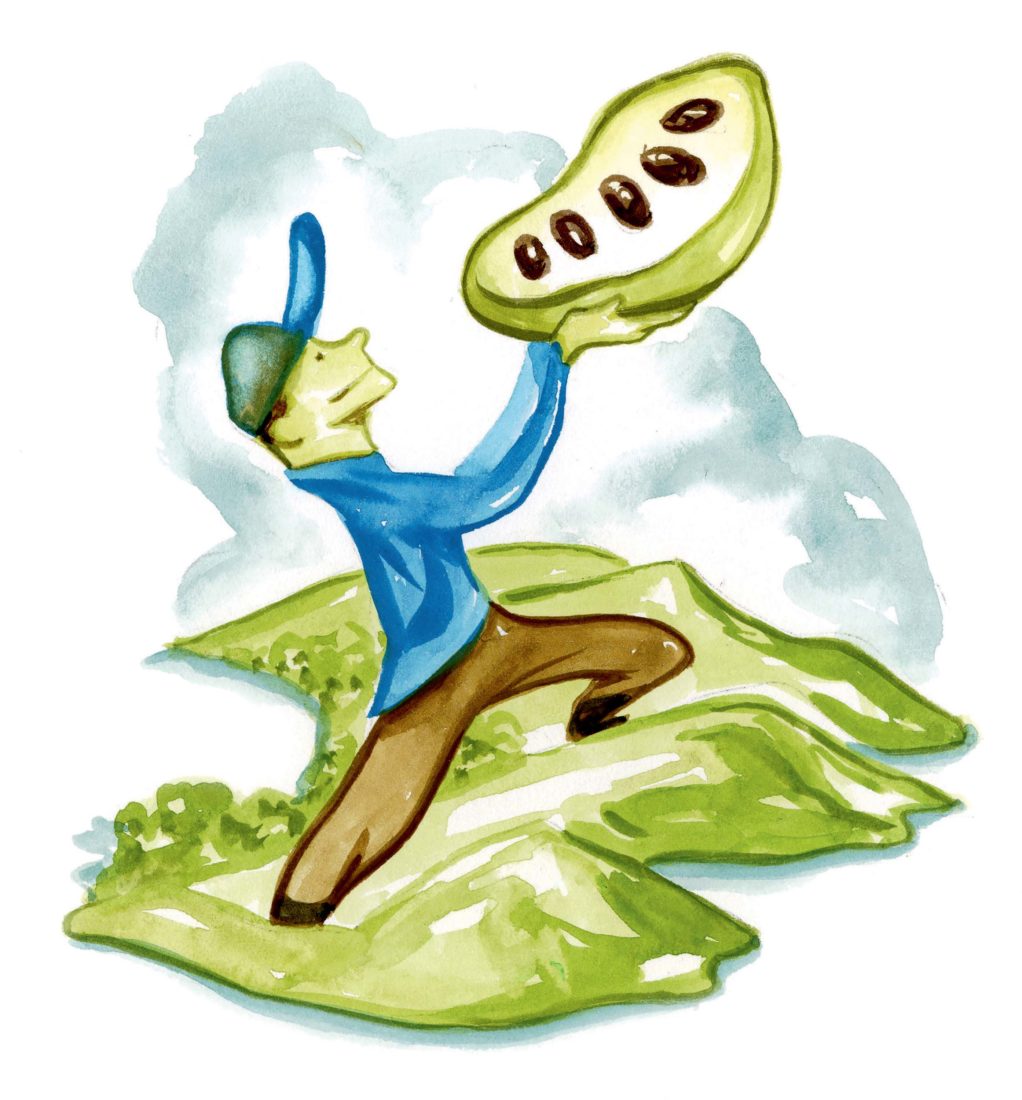
FRUIT
West Virginia
GOLD IN THE HILLS
Some call them hillbilly mangoes; some call them bandangos or West Virginia bananas. “The pawpaw is what you’d get if a banana, a mango, and a pineapple all got together and had a baby,” says chef William Dissen, a West Virginian who worked at the Greenbrier resort before opening three restaurants in North Carolina, including Market Place in Asheville. The soft, tropical-tasting fruit grows wild in the mountains, especially in West Virginia, and when Dissen wants pawpaws during their late summer season, he calls on his network of foragers or takes to the woods himself. “Many a time I’ve blissed out on a trail eating pawpaws,” he says. If he can wait, he’ll make pawpaw preserves with lemon juice, clove, vanilla, and ginger, and then fill Appalachian-style hand pies. For the finishing touch, he sprinkles each pie with coarse cane sugar. In Dissen’s experience, “they usually don’t last long enough to cool.” marketplace-restaurant.com


